Even At Its End, The Universe Will Never Reach Absolute Zero

Once only dark energy remains, empty space still won’t be completely empty.
Imagine, if you dare, the very end of the Universe. The stars — past, present, and future — have all burned out. Stellar corpses like neutron stars and white dwarfs have radiated the last of their remnant energy away, fading to black in color and ceasing to emit any radiation at all. The great gravitational dance of masses within galaxies has come to an end, as every mass has either inspiraled into a black hole or been ejected into the intergalactic medium. And these last remaining structures themselves will decay away, as black holes evaporate due to Hawking radiation, while dark energy drives every unbound structure apart from every other such structure that it isn’t bound to.
At this stage, we’ll have a cold, empty Universe, where the density of matter and radiation has effectively dropped to zero. But our Universe also contains dark energy: an energy inherent to the fabric of space itself. According to our best measurements, it appears that dark energy doesn’t decay, meaning that even as the Universe relentless expands forever and ever, this form of energy density will remain constant. Surprisingly, this fact alone will keep our Universe’s temperature from dropping to absolute zero, no matter how long we wait. Here’s the science of why.
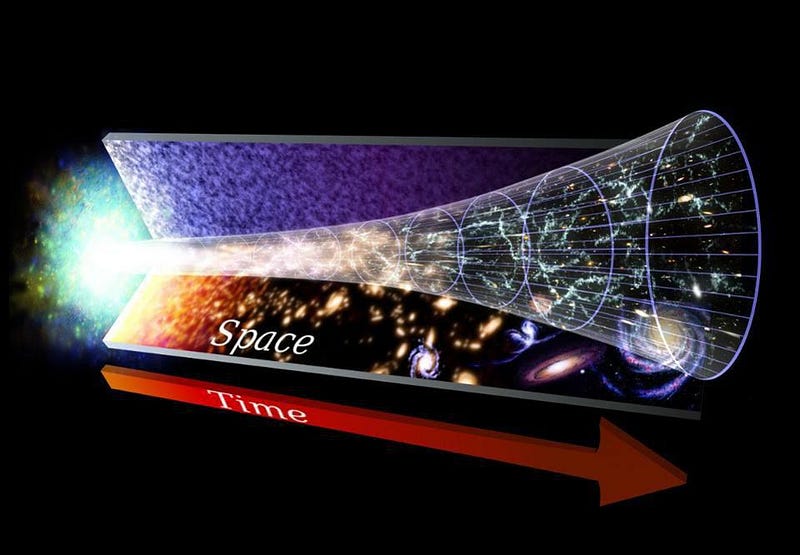
Our story goes back to the early days of modern cosmology: when Einstein’s General Relativity was first published. A Universe governed by Einstein’s rules couldn’t, as was commonly thought to be the case, be filled with roughly equal amounts of material everywhere and still be stable and remain the same size. For generations, it was widely believed that the Universe was static and eternal, providing an unchanging “stage” upon which the matter in the Universe would engage in its cosmic performance. But as Einstein’s new theory of gravitation grew to prominence, many realized that this assumption was a physical impossibility.
If General Relativity governs your Universe, and your Universe is filled with a roughly equal density of “stuff” everywhere — where “stuff” can encompass any and every form of energy that’s possible, including normal matter, black holes, dark matter, radiation, neutrinos, cosmic strings, field energy, dark energy, etc. — there are only two options for what your Universe can do: expand or contract. Every other solution is unstable, and after even an infinitesimal amount of time, will begin expanding or contracting, depending on what your initial conditions were.
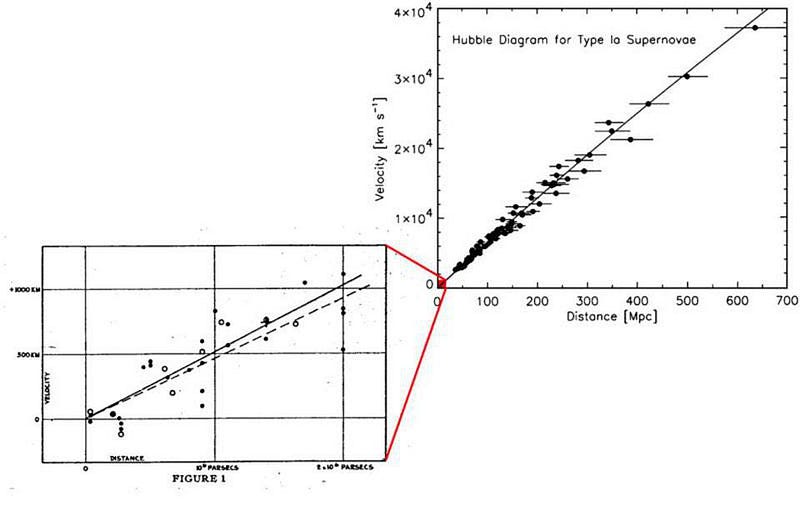
In the 1920s, we began measuring individual stars in other galaxies, confirming their location outside of the Milky Way and their enormous, multi-million (or even multi-billion) light-year distances from Earth. By measuring the spectrum of the light coming from those galaxies — breaking the light up into individual wavelengths and identifying absorption and emission lines from atoms, molecules, and ions — we could also measure the redshift of that light: by what multiplicative factor every individually identifiable line was shifted by.
When we put that data together in the late 1920s, a feat independently accomplished first by Georges Lemaître, then Howard Robertson, and finally (and most famously) by Edwin Hubble, it pointed towards an unambiguous conclusion: the Universe was expanding. Subsequently, this was put together into a framework that became the modern Big Bang, with the discovery of the cosmic microwave background (a leftover bath of radiation from the hot, dense, early stages of the Universe) hammering the final nail-in-the-coffin of possible competing alternatives.
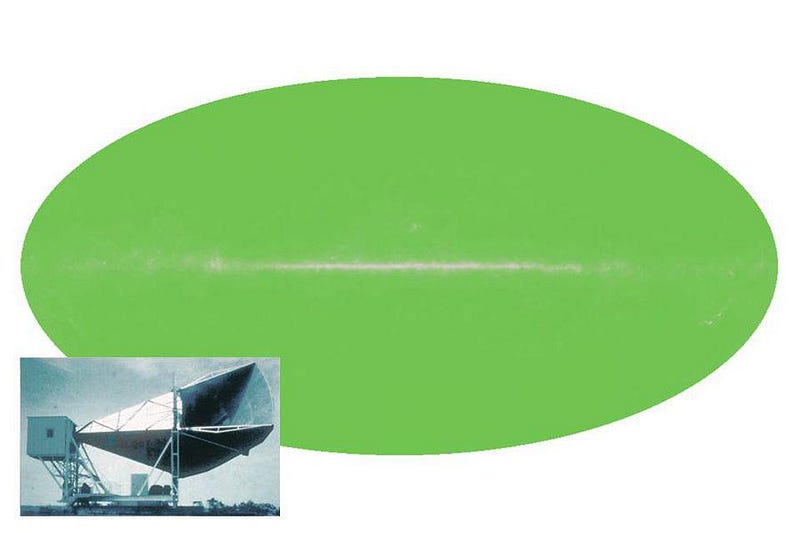
From the 1960s through the 1990s, the science of physical cosmology had two major measurement goals.
- To measure what we called the Hubble constant, H_0, which would tell us how quickly the Universe is expanding today.
- To measure what we called the deceleration parameter, q_0, which would tell us the rate at which a distant galaxy would appear to recede more slowly from us as time went on.
The idea is simple: the equations that govern the Universe dictate a relationship between the matter-and-energy present within it and how the expansion rate will change over time. If we can measure the expansion rate today and how quickly the expansion rate is changing, we can not only determine what makes up the Universe, but we can know its past history as well as its future fate. As the decades went on, new telescopes and observatories were built, and enormous advances in instrumentation occurred, our answers got both more accurate and also more precise.
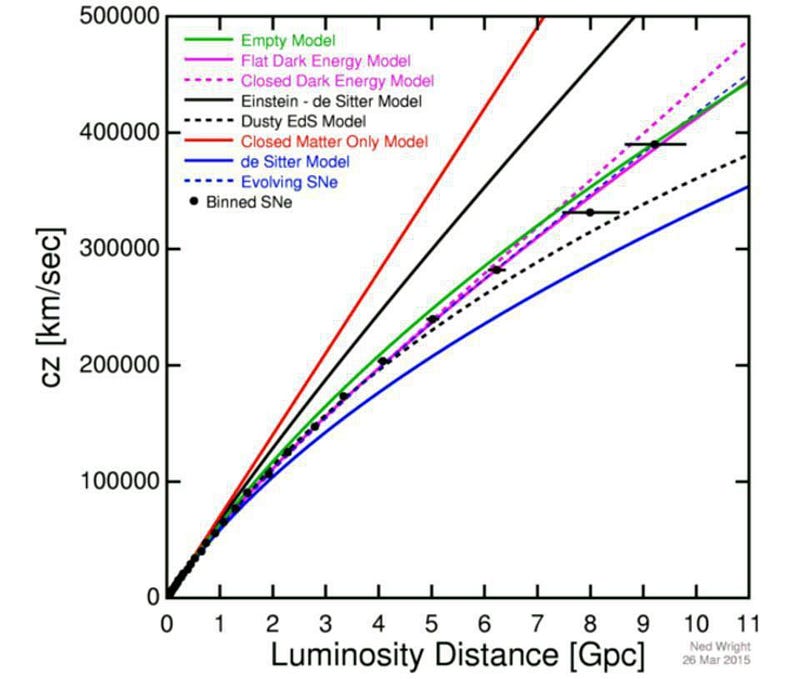
In a Universe filled with matter and radiation, there’s a key relationship between our Universe’s expansion rate and its fate. You can imagine the Big Bang as the starting gun of the ultimate cosmic race: between gravity, on the one hand, that works to recollapse the Universe and pull everything back together, and the initial rate of expansion, which works to drive everything apart. You can imagine multiple different fates:
- one where gravity wins, and overcomes the expansion, causing the Universe to recollapse and end in a Big Crunch,
- one where the expansion wins, where gravity is insufficient, and the Universe expands forever, with its density eventually dropping to zero,
- or one right on the border between those two, a “Goldilocks” case, where the expansion rate asymptotes to zero but never quite reverses.
But when the decisive data came in, it pointed to none of these. Instead, gravitation fought the initial expansion, causing distant galaxies to recede from us at a slower and slower rate, and then something strange happened. About 6 billion years ago, these distant, receding galaxies began moving away from us at faster and faster rates. Somehow, the Universe’s expansion was accelerating.
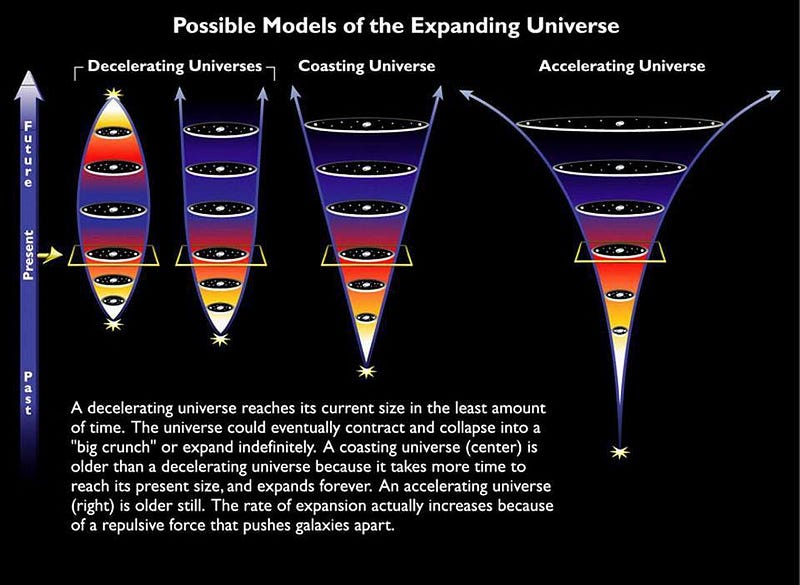
Today, 13.8 billion years after the Big Bang, it’s apparent that the Universe not only contains many different forms of matter and radiation, but also an unexpected component: dark energy. When we look at the modern Universe, we’re seeing it in perhaps its most interesting state: after an enormous amount of interesting, luminous, large-and-small-scale structures have formed, but before dark energy has driven them all away from us to practically imperceptible distances.
In today’s Universe, we see stars forming, living, and dying; we see galaxies and galaxy clusters colliding and merging; we see new planets being formed; but we also see these distant objects speeding farther and farther away from one another. After enough time passes:
- stars will only form from the rare, occasional merger of failed or extinct stars,
- all the shining stars will burn through their fuel,
- stellar remnants will radiate their energy away,
- black holes will swallow a significant fraction of masses,
- galaxies will gravitationally kick out all of the remaining individual masses,
- the leftover radiation from the Big Bang will redshift to arbitrarily low energies,
- and every single black hole will eventually evaporate,
all while the Universe continues to relentlessly expand due to dark energy.
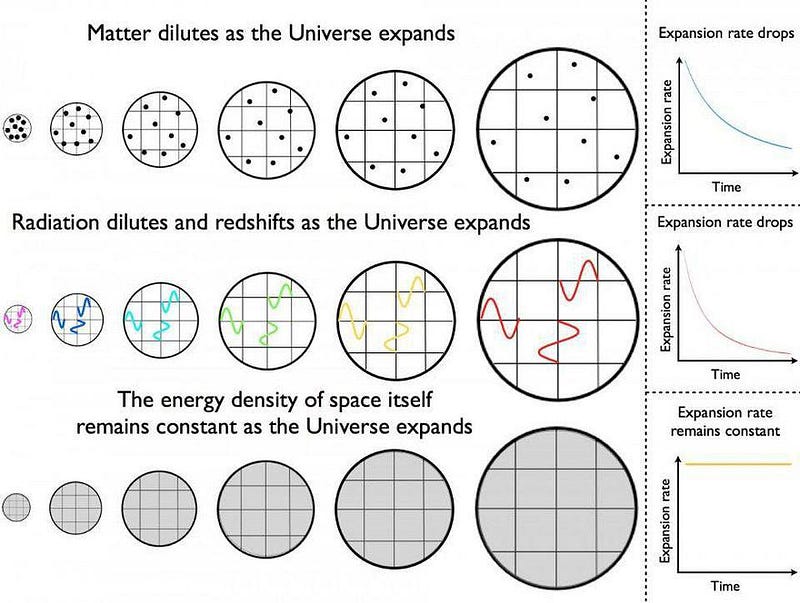
On the levels of individual particles, there may be some incredibly long-term effects that happen far beyond our means to measure them. Protons may decay, although modern experiments have constrained the proton’s lifetime to be longer than ~10²⁵ times the present age of the Universe. Atomic nuclei may undergo quantum tunneling to arrive at a more stable configuration: iron-56 or nickel-60, for example. And improbable but not forbidden events, like the ionization of matter due to a stray, energetic photon, may eventually kick all of the electrons off of atoms and ions.
But, at some point, any arbitrarily large region of the Universe will be completely empty: devoid of all forms of normal matter, dark matter, neutrinos, or any of the radiation permeating the Universe today. Even that great thermal bath of photons created from the Big Bang will shift to long wavelengths, low densities, and energies that asymptote to zero. All that will remain will be the energy inherent to space itself — dark energy — and the consequences that it brings.
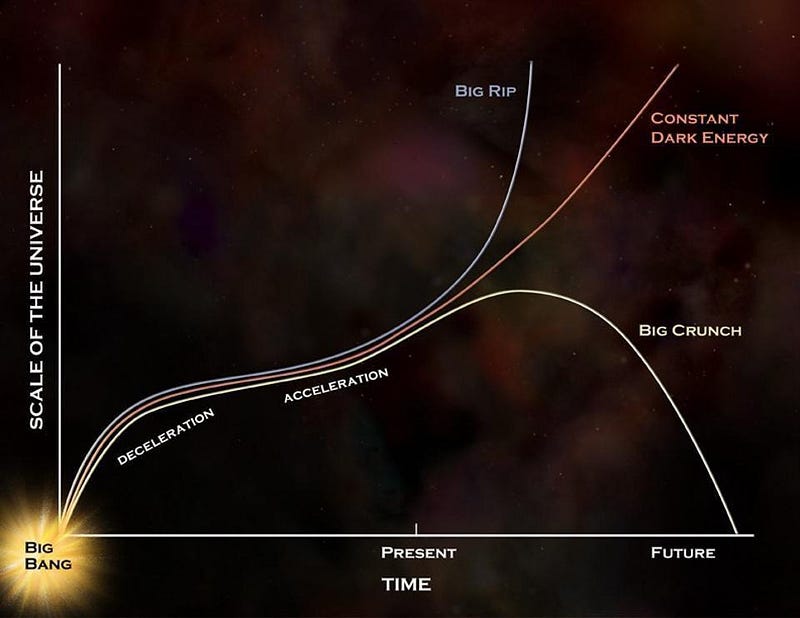
Remarkably, one of those consequences of a Universe with a cosmological constant — the form of dark energy that is best supported by the data, where the energy density of dark energy remains constant over time and throughout all of space — is that the temperature of the Universe does not go to zero. Instead, the Universe will be filled with a bath of extraordinarily low-energy radiation that will appear everywhere, but at an utterly minuscule temperature: ~10^-30 K. (Compare that to the cosmic microwave background today, which is more like ~3 K, or some 10³⁰ times hotter.)
To understand why, we can start by thinking about black holes. The reason black holes evaporate is because they radiate energy, owing to the fact that observers close to the event horizon and observers farther from the event horizon disagree as to what the ground state of the quantum vacuum is. The more severely space is curved near the event horizon of a black hole, the greater the difference an observer there versus far away will experience for the quantum vacuum.

But quantum fields are continuous throughout all of space, and there exist possible light paths that take you from anyplace outside the event horizon to anywhere else outside the event horizon. The difference in the zero-point energy of space between those two locations tells us, as first derived in Hawking’s landmark 1974 paper, that radiation will be emitted from the region around the black hole, with the black hole’s event horizon playing a key role. That radiation will have its temperature set by the mass of the black hole (with lower-mass black holes having higher temperatures), and will have a perfect blackbody spectrum.
We don’t have an event horizon in a Universe with a cosmological constant, but we have a different type of horizon: a cosmological horizon. Two observers in different locations will be able to communicate at the speed of light, but only for a finite amount of time. Eventually, they’ll recede from one another fast enough that an emitted light signal from one will never reach the other, similar to how a signal emitted by us today could only reach an observer ~18 billion light-years distant. Beyond that, they can only receive “older” signals from us, just as we can only receive “old light” from them.
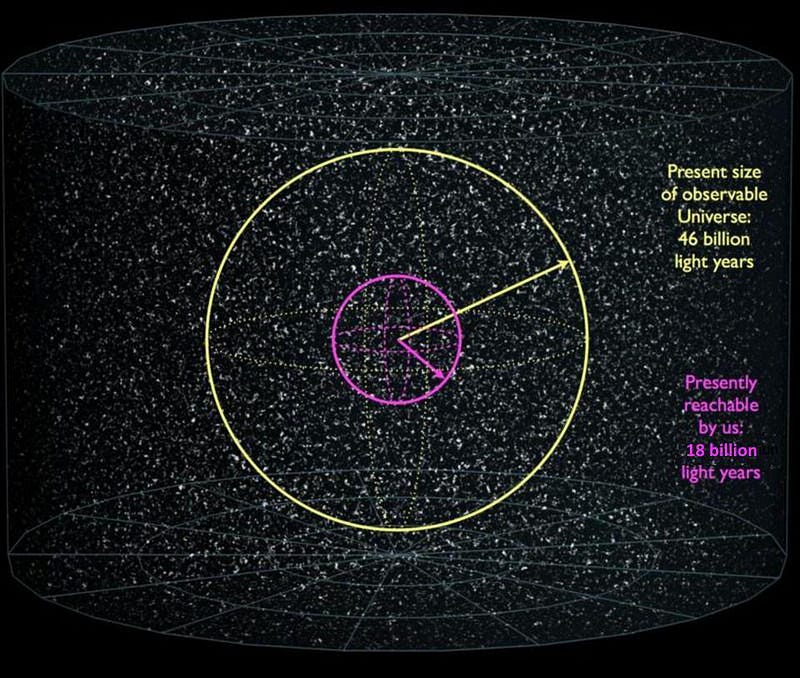
The key that unlocks the entire puzzle is Einstein’s equivalence principle: the idea that observers cannot tell the difference between gravitational accelerations and any other form of acceleration of equal magnitude. If you’re in an enclosed rocket ship and you feel yourself pulled down towards one end, you cannot know whether you’re pulled down because the rocket is at rest on Earth or because the rocket is accelerating in the “up” direction.
Similarly, the Universe doesn’t care whether you’ve got an event horizon or a cosmological horizon; it doesn’t matter whether a point mass (like a black hole) or dark energy (like a cosmological constant) is accelerating two observers relative to one another. In either case, the physics is the same: a continuous amount of thermal radiation gets emitted. Based on the value of the cosmological constant we infer today, that means a blackbody spectrum of radiation with a temperature of ~10^–30 K will always permeate all of space, no matter how far into the future we go.
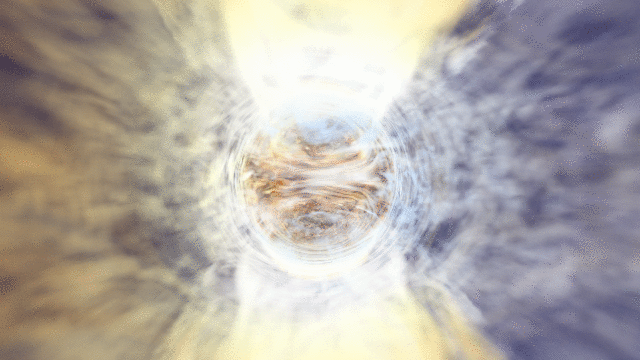
Even at its very end, no matter how far into the future we go, the Universe will always continue to produce radiation, ensuring that it will never reach absolute zero. However, this final-state bath of photons should be tremendously difficult to ever observe. With a temperature of ~10^-30 K, this cosmic radiation should have a wavelength of ~10²⁸ meters, or about 30 times the size of the observable Universe today.
It may be a long journey to the very end, but if what we think about the Universe today is correct, even empty space, as far into the future as we care to go, can never be completely empty.
Starts With A Bang is written by Ethan Siegel, Ph.D., author of Beyond The Galaxy, and Treknology: The Science of Star Trek from Tricorders to Warp Drive.





